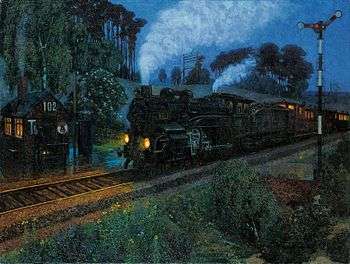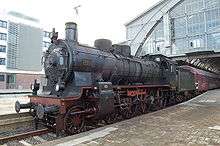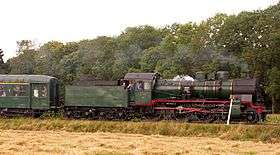Prussian P 8
The Prussian Class P 8 of the Prussian state railways (DRG Class 38.10-40 of the Deutsche Reichsbahn) was a 4-6-0 steam locomotive built from 1906 to 1923 by the Berliner Maschinenbau (previously Schwartzkopff) and twelve other German factories. The design was created by Robert Garbe. It was intended as a successor to the Prussian P 6, which was regarded as unsatisfactory.
| Prussian P 8 DRG Class 38.10–40 | |
|---|---|
 Prussian P 8 in state railway livery | |
| Quantity | ca. 3,700 |
| Year(s) of manufacture | 1908 - 1926 |
| Retired | 1974 |
| Wheel arrangement | 4-6-0 |
| Axle arrangement | 2'C h2 |
| Type | P 35.15 |
| Track gauge | 1,435 mm (4 ft 8 1⁄2 in) standard gauge 1,524 mm (5 ft) Russian Railways |
| Length over buffers | 18,585 mm (60 ft 11 3⁄4 in) |
| Service weight | 69–76.69 t (67.91–75.48 long tons; 76.06–84.54 short tons) |
| Adhesive weight | 50.60 t (49.80 long tons; 55.78 short tons) |
| Axle load | 17.36 t (17.09 long tons; 19.14 short tons) |
| Top speed | 110 km/h (68 mph) (forwards) 50 km/h (31 mph) (backwards) 85 km/h (53 mph) (backwards with tub tender) |
| Indicated Power | 868 kW (1,164 hp) |
| Driving wheel diameter | 1,750 mm (68.90 in) |
| Leading wheel diameter | 1,000 mm (39.37 in) |
| Cylinder bore | 630 mm (24.80 in) |
| Piston stroke | 691 mm (27.20 in) |
| Boiler Overpressure | 12 bar (1,200 kPa; 170 psi) |
| Grate area | 2.58 m2 (27.8 sq ft) |
| Radiative heating area | 14.58 m2 (156.9 sq ft) |
| Superheater area | 58.90 m2 (634.0 sq ft) |
| Evaporative heating area | 143.28 m2 (1,542.3 sq ft) |
| Brakes | Knorr automatic, single-chamber compressed-air brakes, working both sides of the coupled wheels, from 1913 bogie wheels also braked |
| Train heating | Steam from locomotive boiler |
Construction

Because Garbe was an advocate of the simplest possible designs, a straightforward, superheated steam, two-cylinder driving gear was envisaged. The P 8 benefited especially from superheated steam technology, which had just been developed by Wilhelm Schmidt (nicknamed 'hot steam Schmidt'), that led to outstanding performance for those times. The P 8 was a very economical locomotive that did not make great demands on the ability of the engine driver. At the outset Garbe even designed the P 8 as an express train locomotive, with the expectation of attaining a top speed of 110 km/h (68 mph). As a result, the first units were fitted with low-wind-resistance, tapered driver's cabs.
The enthusiasm of crews for the new locomotive was at first muted. The boiler was very effective at evaporation (there was already evidence of a combustion chamber at the front end of the firebox), however against that there were numerous teething troubles, e.g. the driving rod bearings were too small. This led continually to overheating. The loosely coupled Prussian box tender led to disturbing riding qualities when running tender-first. Its riding performance was never fully satisfactory. As a result of poor weight compensation, the top speed estimated by Garbe was never achieved and it was eventually assessed at 100 km/h (60 mph).
One characteristic feature of the P 8 is the large distance between the centre and rear coupled axles. At the outset the P 8 only had a steam dome behind the sandbox; later a forward feed dome was added. Further constructional changes affected, inter alia, the driver's cab roofs, the smoke deflectors and various external assemblies.
There would appear to have been a number of boiler variations. The following combinations can be seen in photographs:
1/. boiler feeds on sides on boiler, steam dome in front of sandbox 2/. boiler feeds on sides of boiler, steam dome behind sandbox 3/. boiler feeds on top of boiler without feed dome, steam dome behind sandbox 4/. boiler feeds on top of boiler with feed dome, steam dome behind sandbox
At least some of very early engines (those with the "V" cabs) carried type (1) boilers and this type appears to have been the standard in the early years. Types (3) and (4) do not seem to have appeared until after World War I but ultimately became prevalent. See "100 Jahre Preussische P8" (Eisenbahn Kurier).
In order to be able to turn the locomotive even on small turntables, the Prussian state railways fitted the P 8 with tenders that originally held 21.5 m³ of water and 7 t of coal. Later the Deutsche Bundesbahn coupled the Class 38 with the tenders of withdrawn wartime locomotives the so-called 'Kriegslokomotiven', especially the bathtub tenders (Wannentender), which could carry more fuel. In addition the top speed when running tender-first was increased from 50 km/h (31 mph) to 85 km/h (53 mph).
On the other hand, the Deutsche Reichsbahn also used tenders of DRG Class 17 steam locomotives that had been taken out of service. These were the so-called long-distance tenders.
Employment

The P 8 could haul 300 t at 100 km/h (62 mph) and 400 t at 90 km/h (56 mph) on the flat and, after the world wars, could be found in almost the whole of Europe. The order to build the first 10 machines was issued to the firm of Schwartzkopff (later the Berliner Maschinenbau) in 1906. With up to 14 express coaches attached, the trial runs went brilliantly. The first engine of this, soon internationally famous, class was placed into service in the Lower Rhine with the number "Coeln 2401".
The P 8 could be used for a variety of duties and was found in heavy express train and goods train services heading almost every train. Even the railway authorities were very pleased with these engines, because the last P 8 locomotives were not mustered out by the Deutsche Reichsbahn until 1972, and by Deutsche Bundesbahn until 1974. More than 500 P 8 engines were in service for 50 years.
The majority of the P 8 class engines were built by Schwartzkopff (later Berliner Maschinenbau) who produced 1025 units, followed by Henschel in Kassel with 742 units.[1] Besides the Prussian state railways, the Grand Duchy of Oldenburg State Railways (Grossherzoglich Oldenburgische Staatseisenbahnen) also bought five and the Grand Duchy of Mecklenburg Friedrich-Franz Railway (Grossherzoglich Mecklenburgische Friedrich-Franz-Eisenbahn) 13 machines. All German locomotive manufacturers later built Class P 8 locomotives including Hartmann and Esslingen.
P 8 Locomotives in the Baden State Railways
In order to compensate for the shortage of locomotives after the First World War as a result of ceasefire reparations and the large number of damaged locomotives, the Karlsruhe railway division reproduced 40 Prussian P 8 engines at the Maschinenbau-Gesellschaft Karlsruhe. They were stationed in Villingen, Mannheim and Karlsruhe, and were given running numbers 1153 to 1192. Under the Deutsche Reichsbahn they were renumbered as 38 3793 to 38 3832 in 1925.
P 8 Locomotives in other countries


In total 3,556 or 3,561 locomotives (according to different sources), were built for German states in 1906–1923, including 60 or 65 for occupation World War I service in Warsaw and Brussels.[1] Of these, 627 had to be transferred to the victorious powers as reparations after the end of the First World War: Poland received 192 (reclassified as the Ok1), Belgium 168 (type 64), France 162, Italy 25 (gruppo 675), Romania 18, Lithuania 11 and Greece 10 locomotives as SEK class Ζδ (ZETA-delta). 41 locomotives were ceded to Saar railways.[1] Up to 1923, the newly founded Deutsche Reichsbahn replenished the fleet of P 8 locos with new machines, and possessed 2933 machines in total, numbered 38 1001 to 3832 and 38 3951 to 4051.[1] In addition to 3,556 or 3,561 produced for the German railways, 65 new locomotives were produced for Poland in 1922–1923 (as the PKP class Ok22), and 95 for Romania (as the CFR 230.000 class), in 1921–1930.[1] Further 226 locomotives were licence-manufactured in Romania in 1932-1939.[2]
A total of 3,948 P 8 locomotives were built (including the inter-war built in Romania), which makes it the most numerous passenger train locomotive ever to be built in the world.
After the Second World War, numbers 38 1069, 1391, 1434, 1677, 1809, 1818, 2052, 2692, 3264, 3495 und 3525 remained in Austria. Number 38 2052 was returned to the Deutsche Bundesbahn in 1952. Locomotives 38 1391, 1434, 1818, 3495 and 3525 went to the Soviet Union. The remaining machines formed the Austrian ÖBB Class 638. In 2004, the Austrian Society for Railway History (ÖGEG) acquired two machines of this type from Romania (the P 8 'copies'), one of which carries out steam 'specials' under the fictitious number of ÖBB 638.1301. Polish locomotives Ok1 were taken over by the Germany during World War II, but along with new reparations, Poland received 429 of former P 8 engines after the war, used in line service until 1981.[2] Three of the class were impounded by British forces after World War II in Norway. They were sent to Copenhagen for repair and eventually were purchased by the Danish State Railways where they became DSB class T numbered 297, 298 & 299. The last survivor was scrapped in 1973.
France
In France, the 162 locomotives received as reparations were divided between five railways:[3]
- The Chemins de fer de l'Est received 25 locomotives. They were renumbered 3311–3335 by the Est, and became 1-230.F.311 to 1-230.F.335 in the SNCF's Région Est list.
- The Chemins de fer d'Alsace-Lorraine received 25 locomotives. They were renumbered 2350–2374 by the AL, and the 22 survivors became 1-230.F.352 to 1-230.F.374 in the SNCF's Région Est list.
- The Chemins de fer du Nord received 75 locomotives. They were renumbered 3.1601 to 3.1675 by the Nord, and became 2-230.C.1 to 2-230.C.75 in the SNCF's Région Nord list.
- The Chemins de fer de l'État received 17 locomotives. They were renumbered 230-943 to 230-958 by the État, and the seven survivors became 3-230.E.943 to 3-230.E.958 in the SNCF's Région Ouest list.
- The Chemin de fer du Midi received 20 locomotives. There were renumbered 3701–3720 by the Midi, became 230-701 to 230-720 in the after the PO-Midi merger, and became 4-230.H.701 to 4-230.H.720 in the SNCF's Région Sud-Ouest list.
During World War II, many of the French P 8 locomotives were taken away by the German authorities, and while most returned, some were lost to East Germany and Poland. After the war, the SNCF decided to concentrate their P 8 locomotives on the Région Est. The État and its successor the Région Ouest had hated its former German locomotives, and withdrawn them as quickly as possible. Consequently, only 3-230.E.943 was still in service in 1946 when it was transferred to Région Est as 1-230.F.343. Of the former Midi locomotives, only 4-230.H.714 did not survive until 1946, when the remaining 19 became 1-230.F.401 to 1-230.F.420. In addition four German locomotives were discovered in France after the war, and these became 1-230.F.600 to 1-230.F.694; later 1-230.F.601 to 1-230.F.604.
Between 1948 and 1950, Région Nord had lent nine locomotives to Luxembourg as CFL 3902–3910. Four of these, along with 9 others were transferred to Région Est in 1950, where they became 1-230.F.210 to 1-230.F.272. The Nord had made extensive use of its P 8s and retained as may as it could. The last P 8 on Région Nord was retired in 1962, and the last on Région Est in 1966.
Preserved P 8 Locomotives

- One of the remaining P 8 locos is the 38 1182, that belongs to the DB Museum at Nuremberg (Verkehrsmuseum Nürnberg). It was built in 1910 by Schwartzkopff in Berlin and has been in operation for 61 years. As of 2008, it is stabled at the Gera engine shed (Bahnbetriebswerk Gera).
- The Bochum-Dahlhausen Railway Museum (Eisenbahnmuseum Bochum-Dahlhausen) owns a working P 8, the 38 2267 (built 1918), that heads trains on nostalgic trips through the Ruhr area.
- Number 38 3199 of the South German Railway Museum (Süddeutsches Eisenbahnmuseum) in Heilbronn has an unusual history. It was built in 1921 by the Linke-Hofmann locomotive factory in Breslau. It was initially designated as 2580 Elberfeld by the Deutsche Reichsbahn and later renumbered to 38 3199. It was last stationed at Breslau locomotive depot. As early as 1926 it was purchased by the Rumanian railways (CFR) and allocated number 230.106. In 1974 it was mothballed. Railway fans discovered it in the scrap yard and had it restored to full operation in Klausenburg in 1999 in the livery of the former Reichsbahn. Since 2002 the locomotive has been deployed again on museum services.
- Since 1977, number 38 2383 has been at the German Steam Locomotive Museum (Deutsches Dampflokomotiv-Museum or DDM) in Neuenmarkt. It was built by Henschel in 1919 and was the penultimate P 8 in the Deutsche Bundesbahn.
- In the Siegen locomotive shed is the last P8 in Deutsche Bundesbahn service. Officially paid off on December 5, 1974, number 38 1772[4] (since 1968 given the computerised number 038 772-0) was still in service until February 13, 1975, for farewell journeys. Built at Schichau in 1915, it had covered 3,719,271 kilometres (2,311,048 mi) before its withdrawal. In the 1980s it was reactivated for steam specials by railway fans. Since it had to be taken out of service in 1993, number 38 1772 is preserved as a mobile memorial.
- In The Polish Railways PKP depot at Wolsztyn the Ok1-359, formerly 38 2155, remains operational.

- State railway trips / Manuel Jussen is the owner of the P 8 engine '2455 Posen', which is stabled at the Dieringhausen Railway Museum (Eisenbahnmuseum Dieringhausen). Number 2455 Posen was built in 1919 by the Linke-Hofmann factory in Breslau under the running number 1804. Sold by the DRG to Romania in August 1926, it was operated there under the number 230 094 until about 1974. After its sale to the present owner in spring 1998 it was restored in Romania in 2001. It represents the period of the early 1920s. The locomotive was used since 2008 as motive power for the "train of remembrance" (Zug der Erinnerung).
- The Austrian Railway History Company (ÖGEG) owns an operational P 8 copy of Romanian origin.
- In Böblingen-Hulb, near Stuttgart, number 38 3650 stands in the car park of a shopping center. It was supplied in 1922 as Elberfeld 3097 to the (Hamburg-)Harburg shed, was on duty there until 1945 and was withdrawn from service in 1972 in Tübingen. Number 38 3650 then stood immobilized in Bahnhof Breitenholz until about the early eighties and then was sold to the shopping center to attract customers. Standing in the open there, the loco has meanwhile become very run down.

- The Belgian heritage railway Patrimoine Ferroviaire et Tourisme (PFT-TSP) bought in 2002 (and transferred in March 2007) a refurbished P8 from Romania. This former CFR 230 084 was repainted in Belgian livery and numbered 64 169 (as National Railway Company of Belgium has owned 168 P8 class 64). It had been manufactured by Henschel with the factory number 18939. In 2013, this loc had a new boiler certification and is authorized to run on the whole Belgian rail network (at 80 km/h).
- The National Railway Company of Belgium has preserved 64.045 in non-running condition, with the tender of 22.153. 64.045 was built by Henschel in 1916, and is currently stored in the museum-depot of Bruges, not open to the public.
Remarks
As early as the end of the 1930s the Deutsche Reichsbahn planned to replace the now ageing P8 by a new locomotive. This led to the development of the DRG Class 23, of which only 2 examples had been built, however, by 1941. In 1950 the Deutsche Bundesbahn began to use the more advanced DB Class 23 as a replacement for the P8. The factories produced 105 examples by 1951. The change of motive power meant that the last Class 23 was withdrawn by the DB only one year after the last P8 had been retired.
See also
- Prussian state railways
- List of Prussian locomotives and railcars
- List of preserved steam locomotives in Germany
References
- Scheingraber, Weisbrod (1993). pp. 32–36.
- Paweł Terczyński (2003): Atlas parowozów, Poznań, ISBN 83-901902-8-1, p. 56 (in Polish)
- Davies 2003, pp. 5–26.
- "38 1772". Eisenbahnfreunde Betzdorf e. V. (in German). Archived from the original on 2008-04-03.
Sources
| Wikimedia Commons has media related to Prussian P 8. |
- Davies, John (November 2003). Société Nationale des Chemins de fer Français locomotive list 1938–1975. Woodbridge, Queensland: Dr. John Davies. ISBN 0-9585541-2-9.CS1 maint: ref=harv (link)
- Wenzel; Gress. 100 Jahre Preußische P8 Eisenbahn-Kurier Special 80 (in German). EK Verlag Freiburg.
- Jochen Kretschmann berichtet in vielen seiner Erzählungen sehr eindringlich über den zeitweise sehr harten Alltag bei der DR(DDR) auf der P 8 (minderwertige Kohle (Braunkohle), Unterernährung, totale Erschöpfung des Personals).
- Harder, Karl Julius (1974). Die P8, Entstehung und Geschichte einer europäischen Dampflokomotive (in German). Stuttgart: Francksche Verlagsbuchhandlung. ISBN 3-440-04116-6.
- Obermayer, Horst (January 2002). Typenblätter Band No. 1 (in German). Eisenbahn Journal Archiv. ISBN 3-89610-093-9.
- MCMXCVII Literary international, inc. Atlas Editions UK LTD. 1998 (printed in EU) D1 613 401(2) 28. Encyclopedic Leaflet system.
- Scheingraber, Günther; Weisbrod, Manfred (1993). Preußen-Report. Band 7: Heißdampf-Personenzuglokomotiven P 6, P 8, P 10 und preußische Tender (in German). Hermann Merker Verlag. ISBN 3-922404-53-7.